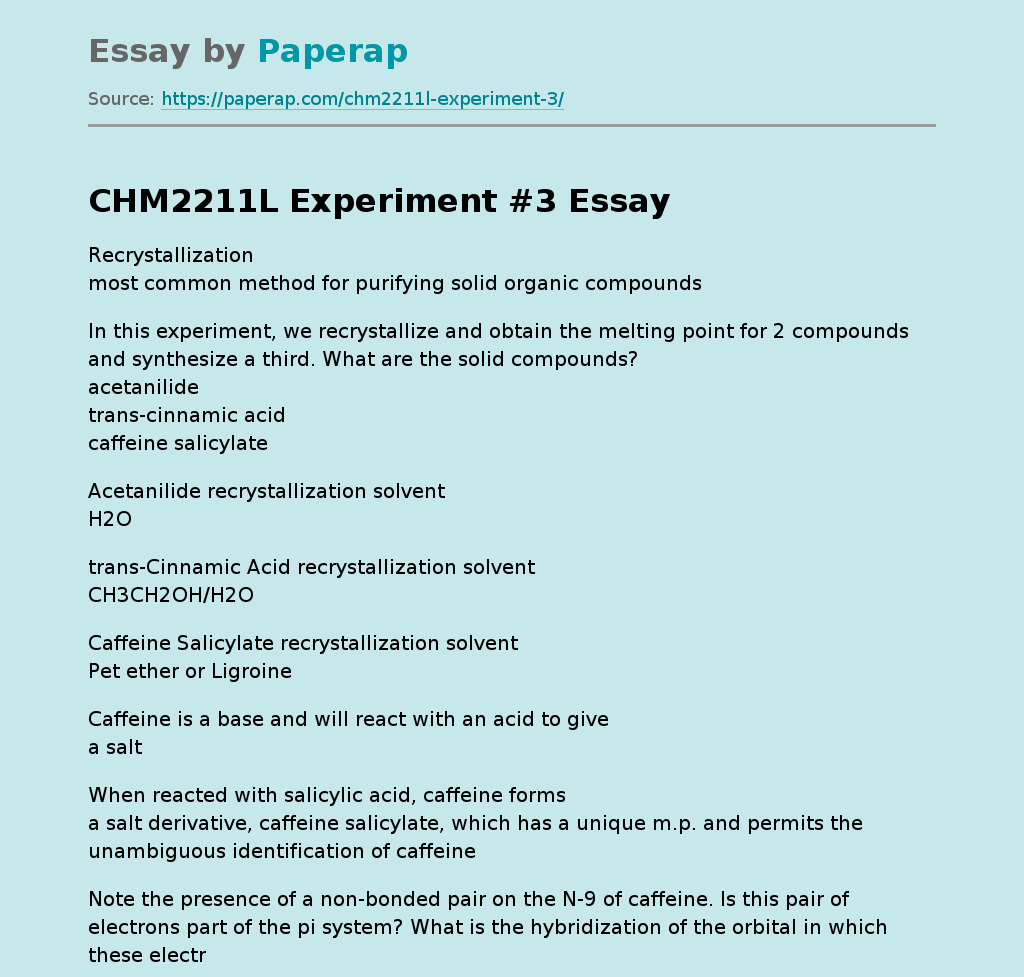CHM2211L Experiment #3
Essay,
Pages 2 (372 words)
Views
48
Recrystallization
most common method for purifying solid organic compounds
In this experiment, we recrystallize and obtain the melting point for 2 compounds and synthesize a third. What are the solid compounds?
acetanilide
trans-cinnamic acid
caffeine salicylate
trans-cinnamic acid
caffeine salicylate
Acetanilide recrystallization solvent
H2O
trans-Cinnamic Acid recrystallization solvent
CH3CH2OH/H2O
Caffeine Salicylate recrystallization solvent
Pet ether or Ligroine
Caffeine is a base and will react with an acid to give
a salt
When reacted with salicylic acid, caffeine forms
a salt derivative, caffeine salicylate, which has a unique m.
p. and permits the unambiguous identification of caffeine
Note the presence of a non-bonded pair on the N-9 of caffeine. Is this pair of electrons part of the pi system? What is the hybridization of the orbital in which these electrons reside? Should the lone pair at N-9 be a good HBA? Would it behave differently or similarly to other lone pairs on the other three nitrogens?
Is the salt complex that is created as simple as it appears in the figure? Review IMF lecture and be prepared to explain
What must we do to dissolve a solid for recrystallization?
heat the solvent
Why must you allow recrystallized samples to dry completely before determining the m.
p.?
Water is an impurity when trying to determine the melting points of crystals. If all the water is not removed, the m.p. will be lower than its actual value.
Give two reasons for knowing the literature solubility data when doing a recrystallization
It provides a known value of when the sample should dissolve and it is also great to use as a reference to the experimental data
Did the literature values for the solubility of acetanilide in H2O hold true? Which solvent system (20 mL or 40 mL) works better for yield? Which for purity?
Give the IUPAC names for both acetanilide and trans-cinnamic acid
Acetanilide: n-phenylethanamide
trans-Cinnamic Acid: (e)-3-phenyl-2-propanoic acid
trans-Cinnamic Acid: (e)-3-phenyl-2-propanoic acid
Consider acetanilide and cinnamic acid samples: which one appeared to benefit the most from recrystallization? How can you tell?
2.Methylbenzamide and 3-nitrobenzoic acid both have a melting point of 140-.1-140.4 degrees celsius. However, if you mixed them together and took the melting point, it would not be 140.1-140.4 degrees celsius. Why not?
CHM2211L Experiment #3. (2019, Feb 01). Retrieved from https://paperap.com/chm2211l-experiment-3/
